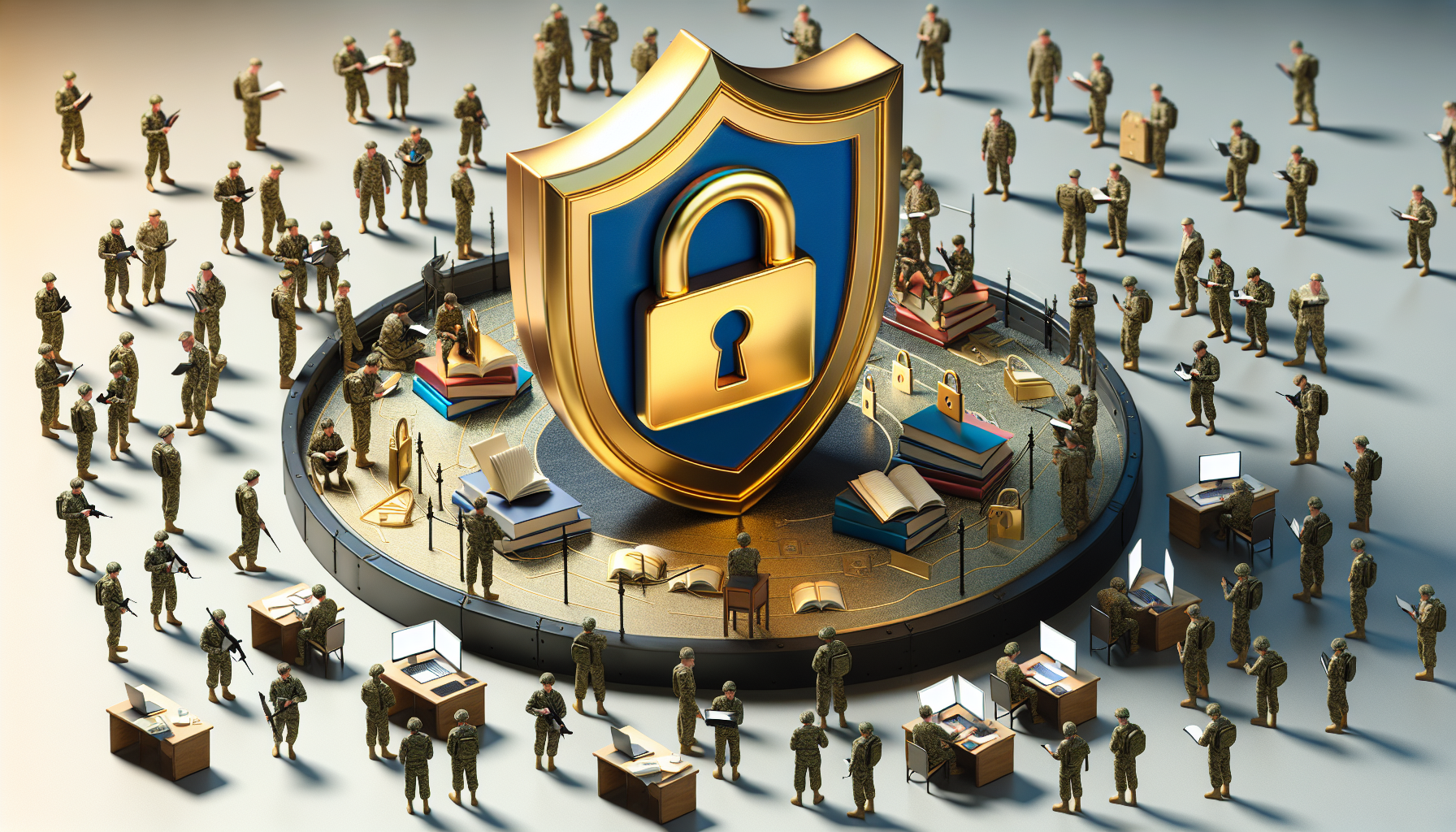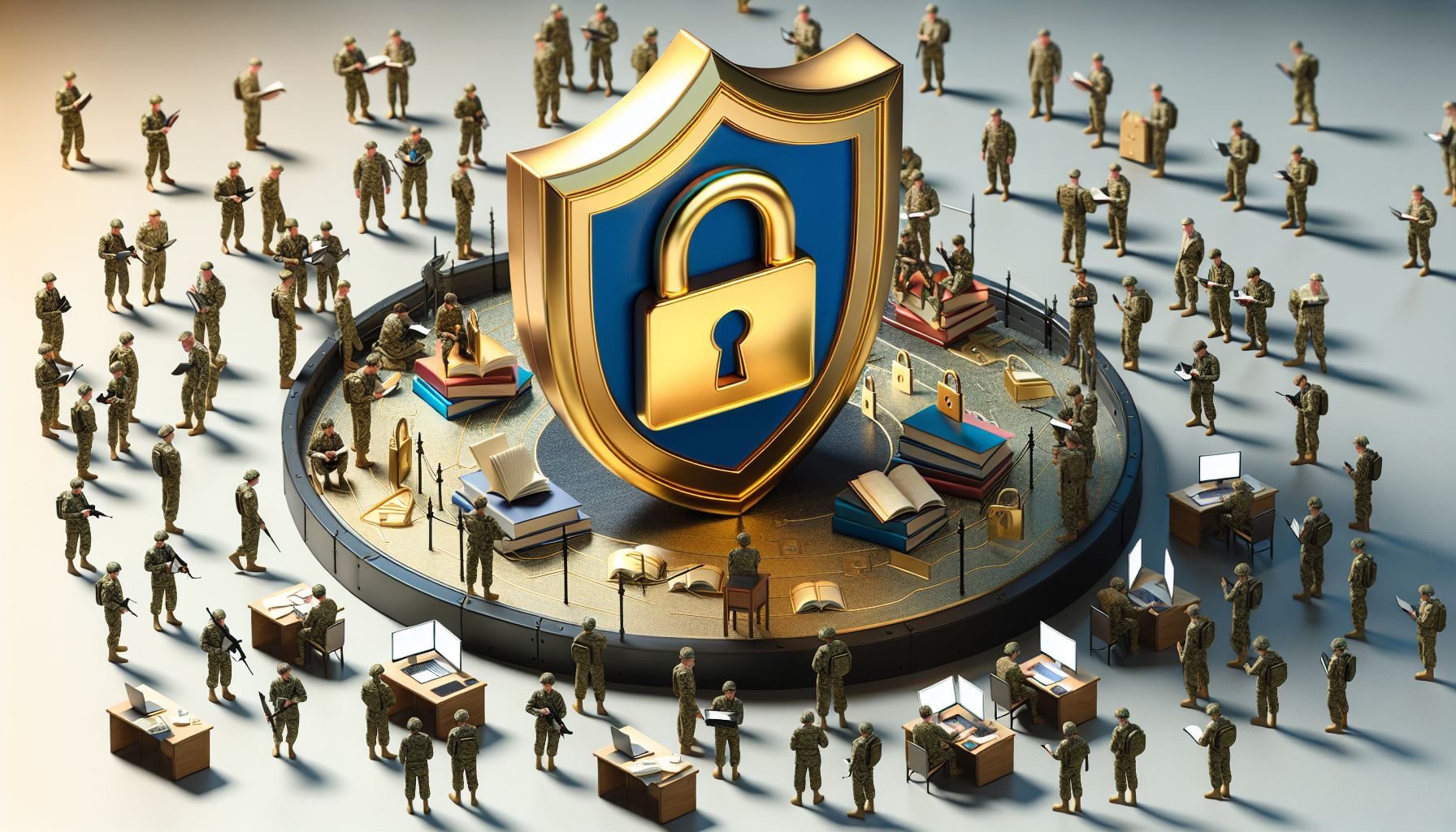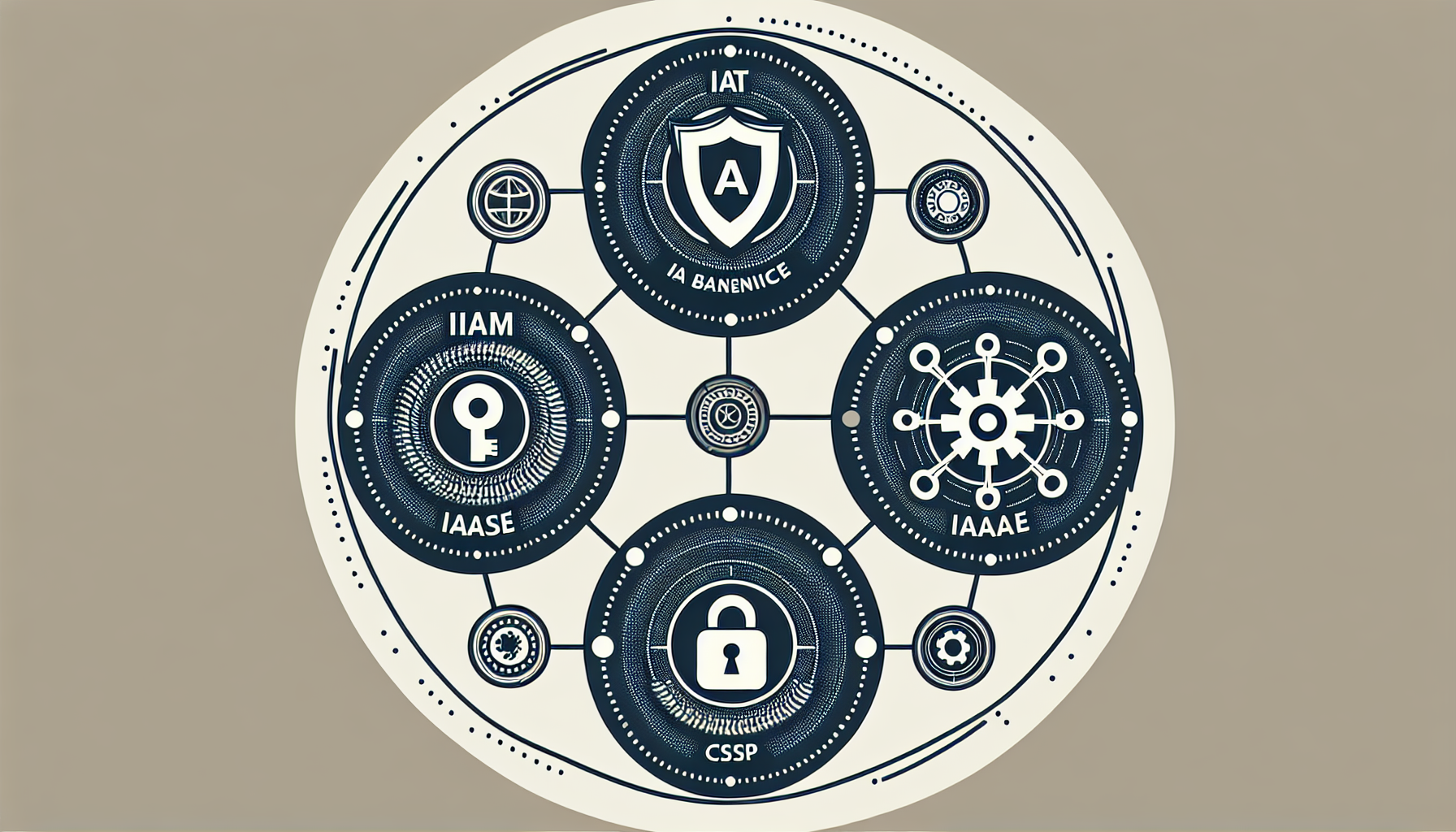
Are you tasked with meeting the Department of Defense 8570 compliance? This crucial directive requires all personnel with privileged access to DoD information systems to earn specific cybersecurity certifications. Navigating DoD 8570 compliance is essential for professionals to maintain their standing and advance their careers within the DoD’s cybersecurity workforce. Our guide cuts through the confusion to clarify what this compliance means for you and outlines the steps to achieve and maintain the required certifications efficiently.
Key Takeaways
- The DoD 8570 directive mandates standardized Information Assurance training and certifications for personnel with access to DoD systems, aiming to bolster cybersecurity measures against rising cyber threats.
- DoD 8570 has evolved into DoD 8140, incorporating NIST and NICE standards to expand the categories of work roles in cybersecurity and ensure dynamic adaptability to emerging technologies and threats.
- Maintaining DoD 8570/8140 compliance requires IA workforce members to earn approved certifications, engage in ongoing education, and fulfill specific Continuing Education credits for recertification.
Understanding DoD 8570: A Comprehensive Overview

The inception of the DoD 8570 directive was a game-changer in the U.S. government’s management of the cybersecurity workforce. It came in response to escalating security concerns and cyber threats like the Code Red Worm of 2001 and the ILOVEYOU virus. This directive established a standardized approach to Information Assurance (IA) training, certification, and workforce management within the DoD, ensuring that personnel were adequately trained and certified.
Before DoD 8570, competency in cybersecurity was gauged primarily through resumes, with on-the-job training addressing new technologies. The directive’s influence extends beyond the DoD, impacting individuals and agencies with access to DoD information systems, contributing to the establishment of a respected skill set certification in the IT industry.
The Purpose of DoD 8570
The DoD 8570 directive primarily focuses on enhancing cybersecurity measures. It seeks to ensure that all individuals with access to DoD information systems are competent and certified to a baseline standard. The directive, which introduced policies requiring certification and training for certain cybersecurity roles, facilitated the structured management of the IA workforce.
The directive sought to achieve the following goals:
- Reduce human error and vulnerabilities in information assurance architecture
- Enforce standardized practices
- Ensure military members or defense contractors with privileged access to DoD information systems possess the necessary skills and knowledge to protect critical information
To meet these goals, achieving DoD Directive 8570 certification requirements became essential.
Evolution to DoD 8140
With the evolution of technology and expansion of the digital landscape, DoD 8570 transitioned into DoD 8140, which carried on the training and certification requirements for information assurance personnel. This transition reflected the dynamic nature of defense and cybersecurity, maintaining robust rules while allowing for adaptability to future developments.
The DoD 8140 model is based on the National Institute of Standards and Technology (NIST) and National Initiative for Cybersecurity Education (NICE) standards, offering clearly defined tasks under each work category known as Special Areas. This evolution expanded the work roles and categories to include:
- Security Provision
- Operate and Maintain
- Protect and Defend
- Analyze
- Operate and Collect
- Oversight and Development
- Investigate
Each category has specific job roles and responsibilities.
Navigating IA Baseline Certification Requirements

DoD IA Workforce members are required to obtain an approved certification for their position category or specialty level, meeting the IA baseline certification requirement. These approved baseline certifications are categorized into several levels: IAT Level I, II, III, IAM Level I, II, III, IASAE I, II, III, and CSSP roles, including technical level ii positions. These certifications cater to various roles such as Analyst, Infrastructure Support, Incident Responder, Auditor, and Manager.
For professionals performing IA functions, understanding these certification categories and levels is vital. The importance of achieving these certifications cannot be overstated, as they are the gateway to maintaining compliance and enhancing one’s cybersecurity career.
Certification Categories and Levels
The DoD directive has set up standardized information assurance certification categories, such as:
- Information Assurance Technician
- Manager
- Computer Network Defense
- System Architecture and Engineering
- Computing Environment
These categories highlight the diverse roles within the IA workforce, where IA personnel are identified, tracked, and managed based on their respective certification category, level, and job function.
A myriad of approved certifications, such as:
- A+ CE
- Security+ CE
- CISSP
- CISM
- CEH
are recognized for various levels within the Information Assurance Workforce under DoD 8570.01-M. These certifications validate the competence of professionals in executing their IA duties.
Achieving Higher-Level Certifications
Securing higher-level certifications strategically aids career progression within the IA workforce. These certifications satisfy the requirements for lower-level certifications, often leading to higher earnings and advanced job opportunities. Certifications approved for higher levels within categories like Information Assurance Technical (IAT) and Information Assurance Management (IAM) are cumulative, which means they meet the requirements of lower levels within those same categories.
Take, for instance, the System Security Certified Practitioner (SSCP) certification. It qualifies for both Technical Level I and II, making it a worthwhile pursuit for professionals aiming to climb the cybersecurity ladder. However, the journey towards higher certifications requires strategic planning, such as leveraging certifications with overlapping content to minimize additional study.
Pursuing Approved Cybersecurity Certifications

Working towards approved cybersecurity certifications is an essential step in meeting DoD 8570 compliance. Organizations like Cisco have their certifications approved by the United States Department of Defense for compliance with DoD Directive 8570. Training providers, including ONLC, partner with most certification vendors approved by the directive, offering the necessary training to prepare for certification exams. The DoD Cyber Exchange platform can be a valuable resource for professionals seeking information on these certifications.
ONLC enhances their training courses with the following additional perks:
- Money-back satisfaction guarantee
- Free refresher course
- Exam preparation
- Certification exam voucher
- Pass guarantee
These perks can be a game-changer, offering confidence and reassurance to professionals pursuing cybersecurity certifications.
Choosing the Right Training Provider
Choosing a suitable training provider is a key step in the path to DoD 8570 compliance. This involves selecting appropriate training vendors by:
- Verifying that the provider is officially recognized
- Checking their track record of student certifications
- Ensuring they offer a relevant curriculum
- Confirming that they are staffed by certified and experienced instructors.
Quality training providers go the extra mile, offering additional assistance such as answering questions about classes, advising on certification options, and providing information about discount opportunities. This support, often provided by a certification provider, can be instrumental in guiding professionals towards achieving their certification goals.
Preparing for Certification Exams
Earning a certification requires extensive preparation. Training providers that include study materials, practice exams, and lab experiences significantly enhance exam readiness. Free online study guides, such as the CompTIA Security+ guide, are valuable resources for exam preparation.
Exam preparation should cover a wide range of topics, including:
- Network security
- Hacking methods
- Device hardening
- Compliance
- Documentation from both technical and management perspectives
Practical experience in hacking, penetration testing, network hardening, and firewall configuration is essential. Using lab workbooks for hands-on practice can be highly beneficial.
A recommended study schedule is approximately two months at two hours per day, incorporating a mix of theory learning, lab exercises, and practice exams.
Maintaining Compliance and Continuing Education

For DoD IA Workforce members, maintaining compliance and upkeeping education is a lifelong commitment. Professionals must recertify every three years to maintain compliance with DoD 8570 directives. Understanding the specific Continuing Education (CE) credits required for each certification is crucial for proper planning and compliance.
Failure to meet recertification requirements can result in losing DoD 8570 compliance and may impact job status. Therefore, professionals must engage in activities such as formal training, relevant job experience, and publications to earn CE credits for maintaining their cybersecurity certifications. A variety of education and training types can fulfill CE requirements, including college courses, publishing papers, or attending relevant conferences.
Recertification and Renewal
Recertification and renewal play crucial roles in preserving DoD 8570 compliance. CompTIA certifications such as A+, Network+, and Security+, earned on or after January 1, 2011, have the ‘CE’ designation and require renewal every three years. Professionals have options such as:
- Completing CompTIA CertMaster CE
- Earning a higher-level CompTIA certification
- Earning a non-CompTIA IT industry certification
- Passing the latest version of the CompTIA exam
DoD personnel with CompTIA certifications must obtain Continuing Education Units (CEUs) for activities and training relevant to their certification every three years. The number of CEUs required varies by certification; for example, Security+ requires 50 CEUs. For those holding multiple CompTIA certifications, renewing the highest-level certification is sufficient to keep the other certifications current.
Staying Informed on Industry Updates
Keeping updated on industry changes is essential for maintaining compliance and remaining effective in the cybersecurity field. Cybersecurity professionals must maintain an up-to-date understanding of the latest trends and changes in DoD directives to remain compliant and effective.
Monitoring and reporting on IA certification and training status is critical for mission readiness and improving the overall cybersecurity posture within the DoD. DoD cybersecurity certifications are indicative of an individual’s commitment to staying current with new technologies, which is key to gaining an advantage in the cybersecurity field.
Case Studies: Success Stories in DoD 8570 Compliance

Securing DoD 8570 compliance marks a significant achievement, paving the way for numerous opportunities. Cybersecurity workers within the Air Force and employees performing Department of Defense DoD work at defense contractors like General Dynamics IT (GDIT) are classic examples of DoD personnel required to meet DoD 8570 compliance standards.
These professionals have successfully navigated the DoD 8570 compliance process, advancing their careers in the process. Compliance with DoD 8570 is pivotal for career progression and maintaining eligibility for certain cybersecurity roles within the DoD and its contractors like GDIT.
Overcoming Challenges in Certification
While the path to certification may pose various challenges, the rewards certainly justify the effort. Some benefits of certification include:
- Increased job opportunities and career advancement
- Higher earning potential
- Enhanced professional credibility and recognition
- Expanded knowledge and skills in your field
Additionally, some individuals may qualify for financial assistance or reimbursement programs to help cover the costs of certification and training. Candidates often have to juggle job responsibilities and personal commitments while finding time to study for certification exams.
Leveraging professional experience in information security or related fields can help to reduce the learning curve for certification topics. Support from colleagues, mentors, or study groups can offer moral support, guidance, and shared resources for exam preparation. Overcoming test anxiety is another challenge, and individuals have used strategies such as practice exams, relaxation techniques, and understanding retake policies should they need to retake an exam.
Leveraging Compliance for Career Advancement
Securing DoD 8570 compliance can contribute to career progression. Higher-level cybersecurity certifications are a key driver for career progression for IT professionals in the defense sector, aiding both in advancing while enlisted and when moving to the civilian job market.
Obtaining such certifications showcases an individual’s commitment to skill enhancement and staying abreast of new technologies. This commitment, combined with the prestige of DoD compliance, can be a strong selling point when seeking advancement opportunities within the defense sector or transitioning to the civilian job market, especially when certifications required are met.
Summary
In conclusion, DoD 8570 compliance is a critical component of a cybersecurity professional’s career. From understanding the directive’s history and purpose to navigating certification requirements and staying informed on industry updates, professionals must engage in a continuous learning journey. The path to compliance may present challenges, but with the right resources and determination, these can be overcome. The end result is a competent, certified professional capable of defending our nation’s critical information systems. So, gear up, and embark on this journey towards compliance, competency, and career advancement.
Frequently Asked Questions
What is a DoD 8570 certification?
A DoD 8570 certification is a set of cybersecurity qualifications required for government IT professionals, established by DoD Directive 8570 to ensure the competency of individuals in cybersecurity roles.
What is replacing DoD 8570?
DoD Directive 8570 has been replaced by DoD Directive 8140, with DoD 8570 now being part of a broader initiative under the guidelines of DoD 8140.
What is the purpose of DoD 8570?
The purpose of DoD 8570 is to ensure that all individuals with access to DoD information systems are competent and certified to a baseline standard, reducing risks and vulnerabilities in information assurance architecture. This standard helps to enhance the security of DoD information systems.
How has DoD 8570 evolved?
DoD 8570 has evolved into DoD 8140 to align with NICE standards, expand work roles and categories, and provide a more comprehensive framework for cybersecurity workforce management.
What are the IA baseline certification requirements?
To meet IA baseline certification requirements, IA Workforce members need to obtain one of the approved certifications based on their position category or specialty level, which are categorized into several levels and roles.